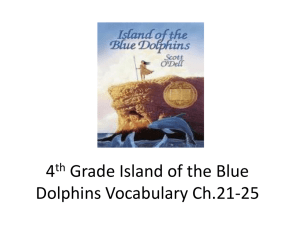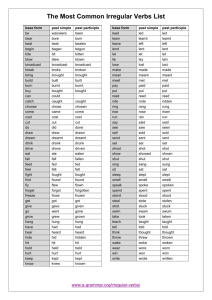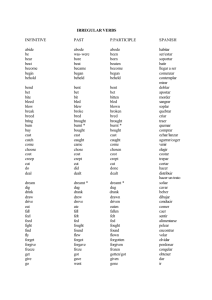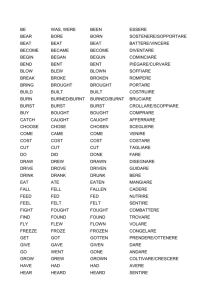Document 11946733
advertisement
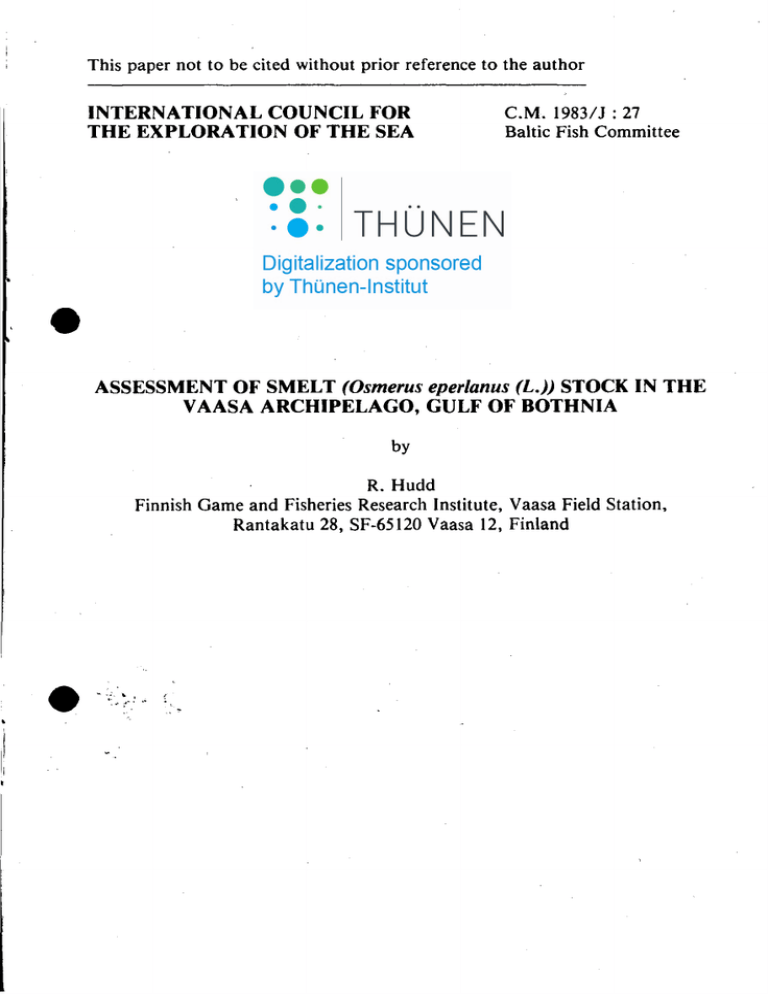
This paper not to be cited without prior reference to the author INTERNATIONAL COUNCIL FOR TUE EXPLORATION OF TUE SEA C.M. 1983/J : 27 Baltic Fish Committee • ASSESSMENT OF SMELT (Osmerus eperlanus (L.)) STOCK IN TUE VAASA ARCUIPELAGO, GULF OF BOTUNIA by R. Hudd Finnish Game and Fisheries Research Institute, Vaasa Field Station, Rantakatu 28, SF-65 120 Vaasa 12, Finland e '.:,>"" .. i l " This paper not to be cited without prior reference to the author International Council for the Exploration of the Sea ASSESSMENT OF SMELT (O~m~~ epektan~ C.M. 1983/J:27 Baltic Fish Committee (L.l) STOCK IN THE VAASA ARCHIPELAGO, GULF OF BOTHNIA • by R. Hudd Finnish Game and Fisheries Research Institute, Vaasa Field Station, Rantakatu 28. SF-65120 Vaasa 12. Finland Abstract According to tagging experiments the smeltfisheries in the Vaasa Archipelago are based on a single population or a number of mixed populations. The schools. when ascending. seem namely to migrate through several fishing areas. In the period of 1978 to 1982 the growth of the recruited age groups, has not changed. According to the age composition of the catches, the recruitment to the vulnerable stock varies quite a lot. The total mortality rate has been valued at 0.7 and the natural mortality rate is assumed to be quite low, close to 0.15. The catches in the area have varied a lot and a decline in the catch/unit effort has been the fact during the period studied. The curves of yield/recruit show that the present recruitment age of 4 is suitable in order to maximize the yield per recruit at the present growth rate. The present fishing mortality apparently gives the highest possible yield. Resurne • D'apres les experlences de marquage, les peches d'eperlans dans 1'archipel de Vaasa sont basees sur une seule population ou sur un nombre de populations melangees. Les bandes semblent migrer a travers plusieurs zones de peches quand elles remontent. La croissance des groupes d'age recrutes n'a pas change pendant la periode 1978-1982. D'apres la composition d'age des prises le recrutement pour le stock vulnerable a varie tres sensiblement. Le taux de mortalite total a ete estime a 0.7 et le taux de mortalite naturelle est estime assez faible, proche de 0.15. Les prises dans la region ont beaucoup varie et un declin dans les prises par unite d'effort ont ete le point marquant pendant la periode etudiee. Les courbes de productivite par recrue montrent que l'age de recrutement actuel de 4 est convenable afin de rnaximaliser la productivite par recrue au taux actuel de croissance. La mortalite de peche actuelle donne apparemment la plus haute productivite possible. 2 Introduction Near1y all of the Finnish commercial catch of sme1t in the sea is caught in the Northern Quark (LEHTONEN 1978). There are no previous studies on the population dynamics of the smelt in the Northern Quark, nor have there been any studies on the reduction in catch on some of the typica1 fishing sites (e.g. HÄSTBACKA & HUDD 1980, AXELL & HUDD 1981.and HUDD et al. 1983a). The aim of this work is to describe the geographical distribution, the migrations, the population parameters and the fishery of the smelt in the Northern Quark. Y/R-curves are presented and the basis for the management of the smelt fishery is discussed. • Materials and methods In 1979, 1980 and 1982, altogether 2940 smelts were tagged; in 1979 and 1980 tagging was done at the beginning of the spawning run, and in 1982 at the end of the run. The tagging took place on typical sme1t fishing sites in the in1ets of the Vaasan eteläinen kaupunginselkä in Vaasa, in Köklotfjärden in Korsholm and in the archipelago off of the River Kyrönjoki in Maxmo (Fig. 1-3). 1400 of these were tagged with Lea tags (BAGENAL 1978) and 1540 with a plastic f1ag tag (GUNDERSEN 1959). The fishes used for tagging were taken from trap nets. They were not anaesthetized although they were held for some hours in capture before being tagged. The tagged fish were released at the same 'p1ace they were caught. During the trapnet seasons random samples were taken from the catches. The total lengths and weights of 2117 smelts were measured. Ages were determined from otoliths. Larvae and fingerlings have been samp1ed with a modified Gulf V (SCHNACK 1974), Gu1f 01ympia (HUDD et a1. 1983b) high speed samplers and with purse seine and fingerling trawls (HUDD et al. 1983a). The growth is described by the von Berta1anffy's equation of growth using a computer program from ABRAMSON (1971). Mortality rates have been estimated from the age compositions in the samples from trap nets. Data on landings andby-eatches are collected from interviews with fishermen and foragers and from the papers of HÄSTBACKA & HUDD (1980) and AXELL & HUDD (1981). Informati~n on the catches in the recreational fishing was taken from SEPPONEN & HILDEN (1982), OSTERHOLM et a1. (1982) and from interviews with sportsfishermen. Yield/recruit curves have been done using JONES' (1957) modification of BEVERTON & HOLT's (1957) method. • j 3 Results -1. • • Distribution area and migrations Until December 31st, 1982, altogether 119 recaptures from the taggings in 1979 and 1980 and 97 recaptures from the taggings in 1982 were reported. 2.5 % of the smelts tagged with streamer tags were recaptured, while 19.8 % and 24.3 % of those tagged with Lea tags in 1980 and 1982 respectively were reported. Most of the recaptures are from the same fishing season but some occurred up to two years after the tagging. The majority of them are from the Northern Quark but there are recaptures reported from as far as the sea area off Pietarsaari and off Kalajoki (Figure 1-3). The recaptures done at the same places in successive years after tagging, indicate that the smelt possess homing. Yet there are recaptures done in .neighbouring fishing areas in the same tagging year as well as in successive years. This indicates that the ascending schools migrate through archipelagoes and inlets where they are fished upon among the homing part of the population. The main part of the stock migrates upstream to the spawning areas in late April and in the beginning of May. Some years the ascension is delayed due to climatic factors and there are observations of spawning in the early summer. The migration is most intensive when the temperature reaches 3-4 oe (Figure 4). The schools ascend at dusk. The spawning takes place in very shallow waters in estuarine areas. After spawning the smelt mi grate to deeper sea areas off the archipelago (Figure 3-4). In the summer schools don't appear in the shallow archipelago. Although schools sometimes dwell in the wintertime in the archipelago, the most important wintering areas seem to be the sea areas off the archipelagoes. The wintering areas are probably already reached in the summer. 2. Growth There are some small differences in the growth rates of the first summer (Figure 5) of different years. Fingerlings caught in a 4 mm trap net in February 1982 had a mean length of 55 mm (min: 49, max: 63 mm, n: 22), which indicates'that the growth stopped at the level found in the trawl samples in November 1981. During the first season of growth the smelt in the Northern Quark thus reaches a length of 55-65 mm. 4 The growth among the harvestable part of the stock hasn't changed during the period 1978-1982 (Figure 6). The mean lengths and weights of the single age-groups in samples from 1978 to 1982 are presented in Table 1. In general, the females grow a bit faster than the males, and are the biggest specimens. Figure 7 shows the growth of the smelt in the Northern Quark according to v. Bertalanffy's growth equation and Figure 8 the length-weight relationship for the samples taken during the spawning period. 3. Age composition of trap net catches and the age of recruitment of new fish to the vulnerable population ~ The catches from smelt trapnets that have a mesh size (bar length) of 10 mm, have consisted of theage-groups 2 to 10 (Figure 9). In the samples from Baltic herring trap net.s,which havea mesh size (bar length) of 12-13 mm, the mean ages are a little older. In general, the recruitment age in trapnet fishing is of 4 years old. From the age-composition (Figure 9) one can see that the mean age in the landings has increased in the period 19781982. As can be seen, this is caused by the high variation in the number of recruits. 4. Survival and mortality According to the age composition in the single samples, the survival rate (S =~) and it's95% confidence limits arecalculated to beO.50:!: 0.05 t (Table 2). This gives a Z value of 0.7. Initial analyses using PAlOHEIMO's method (RICKER 1975) of estimating the natural mortality, indicate that the mortality is low, close to 0.15. By giving the natural mortality the value of 0.15 or 0.2, one obtains, according to Z = F + M, the values 0.55 and 0.5 respectively for the fishing mortality. ~ J 5 5. ~ The main part of the smelt fishing is done with trap nets in the inlets of the spawning areas. Important fishing places are the estuary of the River Malaxä, the inlet of Vaasan eteläinen kaupunginselkä, which is an estuary for three smaller rivers, the inlet to Köklotfjärden and the Maxmo archipelago, which is the estuarine area of the River Kyrönjoki. There are also some smelt fishing with trap nets in the estuaries of the River ~'unsalanjoki and the River Lapuanjoki (Figure 10). The trap net season is very short, usually lasting only two or three weeks (Figure 4). There are no developed gill net fishing activities of smelt in the Northern Quark. There is quite a lot smelt caught in e.g. whitefish fishing. In the late fall and also in the spring the trawl catches of smelt can . be rather big. There is no smelt trawl fishing. The smelt caught in trawls are by-catchesfrom the Baltic herring trawl fishing. The trawling areas in the Northern Quark are on the smelt's wintering areas. The main part of the catches is taken from trap net fishing.during the spawning run in April and May. Estimates of the total catches in 1979-1982 are presented in Table 3. The catches have varieda lot and so have the catch per unit effort values. As an example of this the catch and catch per unit effort values in the landing in Vaasa are presented in Table 4. 6. • Fishing and catches The equilibrum yield per recruit The population parameters used for calculating the Y/R curves are presented in Table 5. Even by increasing the fishing mortality, the yield/ recruit would not grow (Figure 11). One can also see that the overall recruitment age of 4 years gives catches ~hat are very close to the top of the catch per recruit curves at present growth rates. Discussion PAR~~NNE and SJOBLOM (1982) got 3.8 % recaptures when using Lea tags in tagging Baltic herring. They conclude that the Lea tag is more suitable for migration studies than the plastic tag and streamer tag, which gave very few recaptures. In the Northern Quark the recaptures from smelts tagged with Lea tags were 19.8 % and 24.3 % and with streamer tags 2.2 %. Accord- 6 ingly the Lea tag is the more suitable when studying migrations and distribution areas. The rates of recapture are very low, compared for example with McKENZIE (1964), who got even 79 % recaptures. McKENZIE caught the smelts homing in their spawning creeks and there were recaptures done in fishing areas off the coast as well. In the Northern Quark smelt is caught almost entirely for use in forage and the catch is not sorted. This is probably the reason for the lower rates of recapture. Although there is evidence for homing among the smelt in the Northern Quark one can postulate, according to the recaptures of tagged smelts, that the smelt fisheries in the area is based on the same smelt resource, which in the management gives the possibility to treat the smelt in the Northern Quark more or less as an unit stock (GULLAND 1969). When the schools ascend they migrate through archipelagoes and inlets that are important fishing places. Homing among smelt has also been proven by McKENZIE (1964). Although ~lliRAWSKI (1980) found that there is spawning in several spawning sites among some males, the small amount of these does not deny homing among the chief part of the population. The recaptures in the estuary of the River Kyrönjoki of smelts tagged in the inlet of Köklotfjärden.a year before fortifies the assumption that the ascending schools mi grate through several fishing places. The same assumption is further fortified by the recaptures of smelts tagged in one inlet and found in other fishing places in the same fishing season (Fig. 1-3). The adult smelts are found to migrate out of the archipelagoes in the summer. This is also pointed out by NEUMAN (1982) in the archipelagoes in the southern Bothnian Sea •. The reason is the smelts preference for cold waters. The recaptures of smelts tagged late in the spawning season of 1982 show a northward migration in the summer. Yet the majority of the recaptures in the summertime show that all of the smelt do not migrate northward but only move to deeper sea areas off the archipelagoes. According to interviews with trawlers, the catches of smelt are nearly always of equal sizes in the fall and early winter. Fishermen's echograms, that show the smelt schools very close to the bottom, also indicate that the majority of the smelt schools winter there. The large by-catches of smelt in gill net fishing in the wintertime are thus caused by single schools and NEUMAN's (1982) statements claiming that the smelt returns to the archipelago in November and December is not true for all of the population in the Northern Quark. The smelt is known to show large oscillations in the abundance and the success of single year-classes. This is especially known for populations of the small landlocked forms. The reasons for the large oscillations are • I I I I ~ 7 • usua11y natural but there are also observations on remarkab1e changes in densities due to intense fishing (BELYANINA 1969). The mass mortalities mentioned above perhaps have affected the success of the year-classes. The life span of the Quarkenian smelt is very similar to the life spans found in several typical migratory smelt populations in the Sovjet Union (BELYANINA 1969). Thecatches in the Northern Quark have, during the last years, consisted of a remarquably large number of ag(-groups and there is a remarkably high frequency of older age-groups. The reason for the wry age distribution is probably the variable survival of eggs and larvae and it can easily be postulated that the recruitment is not in steady state. The recaptures of tagged smelt are not reliable enough to calculate mortality rates. It is of course also hazardous to approximate mortality rates from the age compositions in catches from samplings in five years and when it is likely that the recruitment during that period has not been in steady state. The given mortality rate has to be considered as preliminary. Yet the presented survival rate agrees with the rates for the populations in the Soviet lakes Lazmiaden, Ladoga, Onega and the rivers Neva, Yenisey, Lena, Chatanga and Anadyr. In these the survival rates are between 0.4 and 0.58 (calculated from age distributions presented in BELYANINA 1969). The mortality rates seem to deviate from those found in Elbe (LILLELUND 1961) and in Miramichi (McKENZIE 1964) Z = 1.34 and Z = 0.92 respectively (calculated from presented age composition), and also from Z = 1.268 presented by NURAWSKI (1978) for the rainbow smelt in Parker River. The sme1t in Northern Quarken grows slower than the smelt in the Gulf of Finland. The difference between the growth in the Quarkenian smelt and the smelt in the northern Gulf of Bothnia is very little (Table 6). Since one can assurne that the smelt during the growth season prefers colder water 1ayers (NEU~~N 1982), which are probably basically the same temperature all over the Baltic, the difference in.growth is either due to differences in population densities or to differences in food supply. Since at least some of the sme1t migrate northward in the summer, the environment during the growing season does not differ much from the smelt TIMOLA (1977) has studied. The smelt is often mixed in the statistics with, for example, Baltic herring catches. In gil1 net fishing the sme1t often is thrown away or sold as forage mixed with roach and cottides. This is one of the reasons there are differences between the official statistics made by the Finnish Game and Fisheries Research Institute and those given in this work (Table 7). The yield per recruit curves indicate that the catches probably wouldn't grow although the fishing mortality would, and that the biggest catches at -- -- ---------------~ 8 present growth are reached,if the recruitment age is kept at 4 years. The catches in Baltic herring trap nets and smelt trap ncts are seldom equal size every year, and some years the overall recruitment age is closer to 5 years than to 4 years. Although the catches in smelt trap nets would dominate and the recruitment age would be 3 years, one cannot assurne that larger catches in smelt trap nets is the reason for the decline in the total catches seen in the last years (Table 7). The reasons for the variations in catches has to be attributed to variations in recruitment and in the climatic circumstances during the short fishing season. Engineering and dredging causes acidification over large areas and mass mortalities have disturbed the smelt fisheries several times (e.g. Anon. 1973, HUDD et al. 1983). The mass mortalities among adult fishes are only a visible sign of the problems that the mortalities among eggs and larvae cause several years later (e.g. HUDD 1982). References Anon. 1973: Selvitys Kyrönjoen ja sen edustan merialueen kalakuolemien syistä. - National Board of Waters (mirneo). ABRAMSON, N.J. (comp.) 1970: Computer programs for fish stock assessment. - fAO Fish Techn. Pap. 101: 1-154. AXEll, M. & HUDD, R. 1981: fiskeriutredning angaende effekterna av 1980 och 1981 ars hamnmuddring och kolhamnsmuddring Vasa uthamn pa Vasklot. - finnish Game and Fisheries Research Institute. 10 pp (mimeo). BAGENAl, T. (ed.) 1978: Methods for Assessment of fish Production in fresh Waters. Oxford 365 pp. BElYANINA, T.N. (ed.) 1969: Synopsis of biological da ta on smelt Osmerus eperlanus (linneaus 1758). - fAO fisheries Synopsis 78. Rome. BEVERTON, R. & HOLT, S. 1957: On the dynamics of exploited fish populations. - U.K. Min. Agric. fish. Invest. (ser. 2) 19: 1-533. GULlAND, J. A. 1969: Manual of Methods for fish Stock Assessment. Part 1. Fish population analysis. - fAO Rome 154 pp. K. 1959: Merkefors~k pa brisling 1958. - fiskeridirektoratets , Smaskrifter 1: 1-17. GUN~ERSEN, • 9 H. & HUDD, R. 1980: Fiskeriutredning angäende effekterna av hamnmuddringen maj 1980 och kolhamnsmuddringen sept. - nov. 1980 i Vasa uthamn pa Vasklot. - Finnish Game and Fisheries Research Institute. 9 pp. (mirneo). H~STBACKA, HUDD, R. 1982: Vesistörakentamisen vaikutukset kalakantoihin jokien suualueilla ja rannikolla. - In: Jutila. E. & Hilden. M. (eds.): Vesistöjen rakentaminen ja kalatalous. Vesi- ja kalatalousalan ammattijärjestöVKA ry. pp. 73-80 • • . HUDD, R., HILDEN. M, URHO, L., AXELL, M. & JAFS, L. 1983: Fiskeriutredning av Kyro älvs mynnings- och influensomrade 1980-1982. - Finnish Game and Fisheries Research Institute. 207 pp. (mirneo). JONES, R. 1957: A much simplified version of the fish yield equation. Contr. Joint. Sei. Meeting ICNAF/ICES and FAO. Lisbon 1957. P 21: 1-8. LEHTONEN, H. 1978: Rannikon sisävesien kalastus vuonna 1976 (Abstract: Fishing of fres~water fishe5 in Finnish Baltic Sea area in 1976). - Suomen kalatalous 48: 25-40. McKENZIE, R.A. 1964: Smelt life history and fishery in the Miramichi River, New Brunswick. - Bull. Fish. Res. Bd. of Canada 144: 1-77. S.A., CLAYTON, G.R. & REED, R.J. 1980: Movements of Spawning Rainbow Smelt, Osmerus mordax, in a Massachusetts Estuary. - Estuaries Vol 3,4: 308-314. ~URAWSKI, E. 1982: Species composition and seasonal migrations of the coastal fish fauna in the southern Bothnian' Sea. In: Müller, K. (ed.) 1982: Coastal research in the Gulf of Bothnia. Hague. pp 317-351. NEU~~N, ~ PARMANNE, R. & SJOBLOM, V. 1982: Recaptures of Baltic Herring tagged off the coast of Finland in 1975-1981. - ICES C.M. 1982/J:19. SCHNACK, D. 1974: On the biology of herring larvae in Schlei Fjord, Western Baltic. - Rapp. p.-v. Reun. Cons. perm. int. Explor. Her. 166: 114-123 • . SEPPONEN, M. &HILDEN, M. 1982: Virkistys- ja kotitarvekalastus Merenkurkun pohjoisosassa· vuonna 1981. - Finnish Game and Fisheries Research Institute (in print). O. 1970: Perämeren kuoreen kasvusta sekä kasvuvertailu muiden pohjoisen pallonpuoliskon suvun alalajien välillä. - Perämeren tutkimusasema, Oulu. 9 pp. (mirneo). TI~IDLA, 10 VOIGT, H. 1972: Bidrag till kännedamen am Brackvattennarsens bialagi Narsen (Osmerus eperlanus L.) i Tvärminne sam exempel. - University af Helsinki. 77 pp. (mimeo). öSTERHOLM, 5., HUDD, R., HILDEN, M.,WAHLGREN, L. & NYBACKA, K. 1982: Husbehovs- ach rekreatiansfisket i Malax, Petalax, Malpe ach Bergö 1981. Vaasa 17 pp. (mimea). • 11 '- 5 -'- 10 ..J'L.- • togging ploct' recopture same seoson • recopture on other time o homing next seoson • homing two seosons toter o Figure I. Recaptures of smelt tagged with the plastic flag tag in the inlet to the Vaasan eteläinen kaupunginselkä. 15 km .......a. ~ Cl ~~ Q <::> f> U D ~tfl) 11 '>. '\ C7 • ~ ~ \l Q !J0-o B l>~~~ D 0 'Uß oQ ~ ... ~ * 0 •• ·0 • 15.4-25.4-80 • 26.4 - 16.5·80 • 17.5:.... 31.5-80 Ä 16 -15.6-80 1.12-31.3-81 11I 17-81 o o Figure 2. Recaptures of smelt tagged with the Lea tag in the inlet of the Köklotfjärden. The arrow indicates the tagging place. • • 1 0 2 4 6 8 km 13 e 5 10 0 NYKARLEBY UUSIKAARLEPY' . 15 km June @ July •e Q August September October Figure 3. Recapture10f smelt tagged with the Lea tag in Maxmo archipelago off Kyrönjoki river. % 'e 25 25 10 20 20 15 15 10 10 0/0 8 4 5 2 5 Figure 4. 10 15 20 25 30 5 10 d 5 10 15 20 25 30 5 10 d Water temperature (--) and smelt catches (~--) during the upstream migration to the Vaasan etelainen kaupunginselkä far the periods 5.4.1976 - 10.5.1976 and 5.4.1978 - 10.5.1978. The smelt catch is shown as the percentage of the total catch in 3 trap nets. • • • 60 L mm 50 • + 1980 1981 1982 o • • 40 0 30 0 20 ." +et • <A> ... 10 ..- 12.11.-81 o + 0 *t ° • + + • + • . • + + + + + o. •• • • • • + + + * • +. +l.. •• • +: 8 Figure 5. The growth of O-year smelt in the years 1980~1982. + + • • • 12.11.-81 lG mm 240 Yl'or of birth 230 1969 1970 220 1971 1972 210 200 1973 190 1974 180 1975 170 1976 160 1977 150 0::: 140 130 • 1980 120 1_ _ '9'1& Figure 6. "" '980 _ _ 1 1 '981 '982 The mean lengths of year classes in samples from 1978 to 1982. • 17 mm 250 200 150 -O,2552Ix+O,27741 y = 220,9314 11- e I 100 1 2 3 4 5 • 7 e , 10 11 12 13 14 15 09' Figure 7, The growth in length according to von Bertalanffy's growth equation, 18 9 100 75 50 -b y=3.2203·10 X 3,12& 25 Figure 8. The weigth/length relationship of upstream migrating smelt. 19 1978 'I. n,100 60 40 40 20 20 2 3 4 5 6 7 8 9 10 11 12 13 1981 n' 252 20 23456789 ./. 60 40 40 1 ~aoooOO~h'" 20 I 2 3 4 5 6 7 8 9 10 11 12 13 14 '/, 60 e 1982 ",1080 Figure 9. LL",198 23456789 1982 ./. 60 40 40 20 20 Z 3 4 5 6 7 8 9 10 11 12 13 n;350 2 3 4 5 6 , 8 9 10 1112 13 234567891011 ./. 60 1979 '60" n 269 2 3 " 5 6 7 8 9 10 11 12 The age composition in the samples from 1978-1982. The left calumns are fram Baltic herring trap nets and the right calumns fram smelt trap nets. 20 • x +KORSNÄS L- Figure 10. 10 L.' 20 km ~, Smelt fishing areas. Arrows show trap net areas and x shows trawling areas. The sizes of arrows do not indicate the magnitude of the fishing nor the catches. 21 .R f/ 1000R 2.4 2.4 2.3 23 2.2 2.2 tr: 4 Ir= 2 2,1 = Ir 4 tr : 3 Ir = 3 2.1 2.0 Ir = 2 2.0 Z = 0.7 Z = 0.7 M = 015 1.~ 1.9 1.8 1.8 1.7 1,1 0.1 02 0.3 0.4 05 0.0 0.7 08 o.~ 1.0 1.1 1.2 F 101=02 0.1 0.2 0.3 0.4 0.5 0.0 0.1 0.8 O.~ F f I. Figure 11. The Y/R-curves at present growth rate of the smelt in the Northern Quarken. The dots indicate the present rate of fishing mortality. Table 1. The mean lengths and weights of age groups in the samples from 1978-1982. agl~ n xL sL 1980 1979 1978 Xw Sw n . xL . sL . xw Sw . n . xL . .\ .. Xw Sw 1 122.0 0 11.0 0 16 122.4 3.86 2 3 17 128.4 6.07 12.6 2.10 19 136.9 4.26 13.7 2.69 66 131.6 6.50 4 61 138.5 5.28 14.5 2.62 136 148.2 4.85 20.0 2.7E 39 152.6 4.92 5 17 153.2 5.07 20.4 3.34 ! 113 159.2 5.34 25.0 3.28 68 162.1 5.03 6 3 168.7 3.51 26.3 2.08 49 172.2 2.92 32.4 3.45 92 174.? 4.08 14 186.65.16 41.8 6.42 87 184.83.01 7 7 193.6 3.28 45.1 3.79 70 195.4 5.38 8 3 198.3 8.5032.7 12.12 20 202.5 5.25 9 66.0 0 4 210.0 6.08 61.5 8.72 3 215.7 0 10 1 21.1 0 3 224.0 7.07 70.7 12.73 4 222.0 4.51 11 65.0 0 1 203.0 0 12 - 13 14 - - - - • 1981 7.3 12.7 20.6 25.4 32.0 38.5 47.3 54.4 68.3 67.8 1.21 2.04 2.72 3.04 3.89 4.17 5.60 5.61 0 6.93 n 2 54 116 68 45 52 51 44 8 7 1 1 1 xL sL 125.5 134.8 143.9 159.2 170.9 180.7 195.5 204.7 212.6 220.1 230.0 247.0 242.0 0 2.39 3.62 4.16 3.74 4.88 7.17 7.38 9.07 6.17 0 0 0 • 1982 Xw Sw 11.0 14.8 18.9 24.6 30.1 36.8 46.8 54.7 55.4 66.9 81.0 71.0 87.0 0 2.48 3.00 3.85 5.35 4.86 9.01 8.11 7.86 8.05 0 0 0 n 14 34 132 201 132 66 77 47 29 13 8 1 - xL 121.9 133.9 145.6 157.1 167.0 177.6 190.2 201.5 216.9 218.0 225.8 230.0 x~~ 11.1 15.5 18.8 24.1 29.4 35.9 45.5 53.4 67.2 68.1 77 .4 88.0 N N 23 Tab1e 2. Trap net samp1es from 1978 to 1982 and the S va1ue calculated from the falling part of the age composition. sample e e Vaasa Sundom Korsholm Kök10t Vaasa Sundom Vaasa Sundom Korsholm Köklot Maxmo Brudsund Vaasa Sundom Vaasa Sundom Vaasa Sundom Korsholm Köklot Korsholm Köklot Korsholm Köklot Maxmo Särkimo Maxmo Särkimo Korsholm Köklot Korsholm Köklot Maxmo Brudsund Maxmo Särkimo Vaasa Sundom Vaasa Sundom 4.5.1978 11.4.1979 30.4.1979 17.4.1979 3.5.1979 7.5.1980 10.4.1980 28.4.1980 29.4.1980 15.4.1980 23.4.1981 14.5.1981 11.5.1981 22.4.1981 11.5.1982 26.4.1982 13.5.1982 12.5.1982 4.5.1982 10.5.1982 % trap net n ~ herring herring herring herring herring smelt herring herring herring herring herring herring smelt smelt herring herring smelt smelt herring herring 100 100 100 100 50 80 100 101 102 82 154 98 100 98 118 140 135 134 106 119 21 42 28 36 46 21 61 50 71 54 60 80 23 33 85 55 39 24 42 45 S 0.27 0.46 0.58 0.54 0.54 0.55 0.32 0.47 0.57 0.65 0.50 0.31 0.54 0.38 0.57 0.66 0.40 0.52 0.58 0.61 Table 3. The total catch (tonnes) in smelt fisheries in the Northern Quark 1979-1982. 1979 1980 1981 1982 trap net (spawning run) by-catch in herring trap net fishing 1) trawl by-catch in gi11 net fishing recreationa1 fishing 160 191 56 106 32 20 12 8 38 20 12 8 11 20 12 8 21 20 12 8 total 232 269 95 155 t) given as 20 % of the catch during spawning run (according to interviews) Table 4. year 1976 1977 1978 1979 1980 1981 1982 Table 5. The smelt catches in the inlet to the Vaasan eteläinen kaupunginselkä 1976-1982. The data on catch for 1976-1980 according to HÄSTBACKA and HUDD (1980) and on catch for 1981 from AXELL and HUDD (1981) • catch (kg) 94 18 46 5 29 4 6 475 275 200 345 465 340 640 catch/trap net 5 1 4 1 5 2 1 905 828 200 336 892 170 328 catch/trap net/day (n: 16) (n: 10) (n: 11) (n: 4) (n: 5) (n: 2) (n: 5) 72 225 145 82 The population parameters used for the smelt in the Northern Quark. Age at recruitment (t r ) Max. age in years (tA) Age at zero length (t ) O Exponent of length weight equation (6) Max. length (Lw) Max. weight (Ww) Growth coefficient (K) Total mortality (Z) Natural mortality (M) Fishing mortality (F) Annual mortality (A) 3 4 14 - 0,2774 3,126 220,9 68 0,2552 0,70 0,15 0,55 0,50 (247 observed) (87 observed) 0,2 0,5 e ~ I r 25 Table 6. age The growth in length of the smelt in the Gulf of Finland (VOIGT 1972), Northern Quark and the northern part of the Bothnian Bay (TIMOLA 1970). The lengths from Northern Quark are 1978-1981 means. VOIGT (1972) Tvärminne 0 2 cf 3 cf ? e ? 4 cf ? 5 cf ? 6 cf ? 7 8 9 10 11 12 13 14 • Table 7. year 1976 1977 1978 1979 1980 1981 1982 cf Northern Quarken 142,18 140,4 157,28 159,03 173,75 180,80 185,57 195,64 194,0 230,0 230 TIMOLA (1970) Bothnian Bay 57 122,7 66,3 116,6 133,6 137,0 147,1 151,4 160,0 165,0 172,9 174,0 183,6 195,3 203,8 212,5 221,5 230 247 242 The total catch of smelt in the sea area between Oravainen and Korsnäs according to the statistics of the Finnish Game and Fisheries Research Institute and interviews with foragers and fishermen. statistics tonnes interviews tonnes 303 155 236 98 249 74 232 269 95 155

